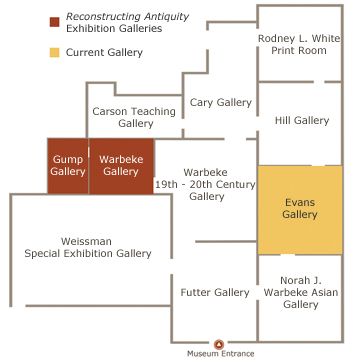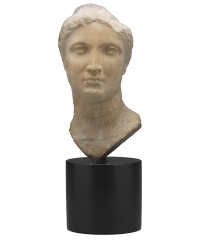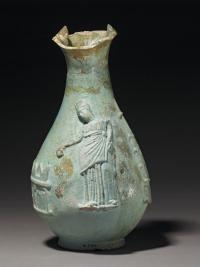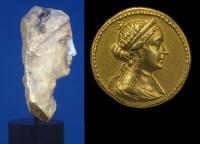Portrait of a Ptolemaic Queen, possibly Arsinoe III
Learn more about the object below
By all accounts, Arsinoe III Philopater (ca. 245–204 BCE) was a remarkable woman. A highly educated member of the Ptolemaic dynasty, she reigned as Queen of Egypt after marrying her brother, Ptolemy IV, in 221/220 BCE, until she was murdered in 204 BCE in response to her role as regent for her 6-year-old son, Ptolemy V. The Greek historian Polybius reports that Arsinoe accompanied her husband into battle at Raphia in 217, an event also recorded in the ancient text, 3 Maccabees. According to the poet and mathematician Eratosthenes, the queen condemned her husband’s infamous worldly excesses, providing a counterweight to the stereotypical decadence of the Ptolemies.
Like the Egyptian pharaohs and Ptolemaic rulers before them, Arsinoe III and Ptolemy IV were worshipped as gods. Known as the Theoi Philopatores, they were inducted into the Ptolemaic cult in Alexandria and in 199/8 BCE their son, Ptolemy V, established an eponymous priestess dedicated to Arsinoe’s worship. This idealized head from the Yale collection may have been created for cult worship, but more likely is from one of the temple relief sculptures that included Arsinoe’s portrait; Ptolemy IV decreed that all temple images made to commemorate his victory at Raphia must be accompanied by a depiction of Arsinoe, illustrating her influence and popularity.
There are several challenges to decisively identifying this Ptolemaic queen’s portrait head as being of Arsinoe III (r. 221/220–204 BCE). Unfortunately, she’s now missing most of her hair (which in antiquity would have been added in stucco), and so lacks the distinctive chignon seen in Arsinoe’s portraits—parted in the middle with a low, prominent bun near the nape of her neck. Furthermore, her current nose is a completely modern product of restoration. That being said, her heavy eyelids and wide cheekbones are very much consistent with the portraits of Arsinoe III seen on Ptolemaic coins and sculptures.
Label text by Emily Wood (MHC ’09), Art Museum Advisory Board Fellow, Mount Holyoke College Art Museum.
Suggested Reading:
Athenaeus. The Learned Banqueters, Book VII 276 a-c.
Barr-Sharrar, Beryl. “The Anticythera Flucrum Bust: A Portrait of Arsinoë III.” American Journal of Archaeology, Vol. 89, No. 4 (Oct., 1985): 689-692.
Hölbl, Günther. A History of the Ptolemaic Empire. Translated by Tina Saavedra. London & New York: Routledge, 2001.
Polybius. The Histories, Book V.




